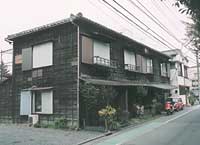|
|
|||||||
|
|
|||||||
|
|||||||
| | Web Japan >>| Trends in Japan >> | Lifestyle >> | Home Is Where the Art Is | |
|
HOME IS WHERE THE ART IS Breathing New Life into Old Homes (January 21, 2004) Modern wooden houses in Japan are said to last about 30 years. But rather than rebuilding their homes at the end of this period, there is an emerging trend for people to remodel their homes to suit changing family needs. Aside from the facts that renovating is cheaper than rebuilding and that the former generates less waste, another factor that cannot be dismissed is the impact of a popular weekly television show in which actual houses are beautifully made over. Eager to get the most out of the trend, homebuilders are beginning to focus on driving demand for home renovation.
TV Show Ignites Boom Focusing on the family that requested renovation and the architect who has been assigned the job, the show reports in documentary style the two months during which a house is revamped. The problems that clients have with their homes are various: To give a few instances, requests have come in from parents who need more space in the house because their coresiding son will be marrying and his wife will be joining the family, a son whose mother has become ill and bedridden, a family whose ties have been torn apart because of a small living room, and a family suffering from lack of sunlight due to the erection of a building next door. The point of the program lies in how the architect faces the challenge of solving these problems. The TV crew stays around the house throughout the duration of the project and documents the process in detail. When the show started in April 2002 it did not go down well, as the public wondered what was so exciting about watching worksites on television. Eventually, though, viewers seem to have found it interesting after all, and now the show boasts viewer ratings in the twenties in spite of the fierce prime-time competition. With every call for requests, the TV station hears from nearly 300 families. The staff members actually visit and survey the homes and select families that are seriously troubled. Whereas most TV shows on housing zoom in on unique residences and comfortable home living, this one focuses on the human drama that unfolds as a house is reborn. The inhabitants' faces transform when they see their homes renewed, making the show seem like a tale with a happy ending. As the producer, Iwata Jun, puts it, "The drama that arises from the encounter between an ordinary family and a skilled professional is what won the support of viewers."
Homebuilders Get In on the Act It cannot be denied that the prolonged recession has also been a prominent factor behind the current boom in home renovation. One successful business by a major homebuilder involves revamping old houses into an "as good as new" state at half the cost and time as actually rebuilding the house. And then there is the fact that demand for new houses is shrinking due to a declining birthrate. Homebuilders are relocating more personnel from their new housing operations - hitherto their main concern - to their renovation operations. At a recent symposium on housing, one expert gave the view that demand for home renovation will jump in coming years, noting, "In terms of a marathon analogy, the current boom in home renovation is still at the two-kilometer point and is yet to gain real momentum. According to estimates given by a leading economic research institute, the home renovation market grew 0.9% from 2001 levels to ¥7.12 trillion ($64.73 billion at ¥110 to the dollar) in 2002. Furthermore, the institute expects the market to expand 17.1% compared to 2002 levels by 2010 and 33.9% by 2020, reaching ¥9.54 trillion ($86.73 billion). Faced with a fast-growing market, homebuilders are drawing up strategies and gearing up to meet the new demand in haste. Copyright (c) 2004 Web Japan. Edited by Japan Echo Inc. based on domestic Japanese news sources. Articles presented here are offered for reference purposes and do not necessarily represent the policy or views of the Japanese Government. |
ELIZABETH KIRITANI (October 30, 2002) THE HOUSE OF THE FUTURE (April 11, 2002) |
|
|



